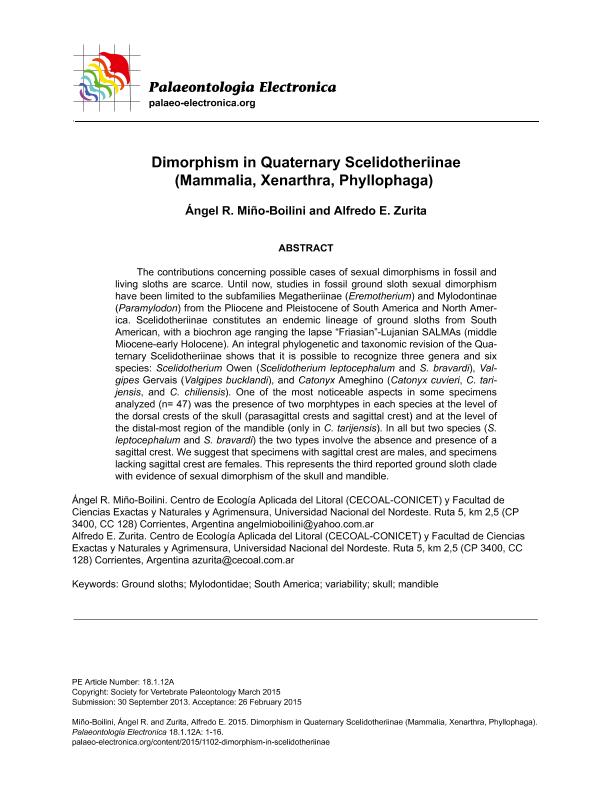Mostrar el registro sencillo del ítem
dc.contributor.author
Miño Boilini, Ángel Ramón

dc.contributor.author
Zurita, Alfredo Eduardo

dc.date.available
2017-10-06T20:40:50Z
dc.date.issued
2015-03
dc.identifier.citation
Miño Boilini, Ángel Ramón; Zurita, Alfredo Eduardo; Dimorphism in quaternary scelidotheriinae (mammalia, xenarthra, phyllophaga); Coquina Press; Palaeontologia Electronica; 18; 1.12A; 3-2015; 1-16
dc.identifier.issn
1094-8074
dc.identifier.uri
http://hdl.handle.net/11336/26185
dc.description.abstract
The contributions concerning possible cases of sexual dimorphisms in fossil and
living sloths are scarce. Until now, studies in fossil ground sloth sexual dimorphism have been limited to the subfamilies Megatheriinae (Eremotherium) and Mylodontinae (Paramylodon) from the Pliocene and Pleistocene of South America and North America.Scelidotheriinae constitutes an endemic lineage of ground sloths from South American, with a biochron age ranging the lapse ?Friasian?-Lujanian SALMAs (middle Miocene-early Holocene). An integral phylogenetic and taxonomic revision of the Quaternary Scelidotheriinae shows that it is possible to recognize three genera and six species: Scelidotherium Owen (Scelidotherium leptocephalum and S. bravardi), Valgipes Gervais (Valgipes bucklandi), and Catonyx Ameghino (Catonyx cuvieri, C. tarijensis, and C. chiliensis). One of the most noticeable aspects in some specimens
analyzed (n= 47) was the presence of two morphtypes in each species at the level of
the dorsal crests of the skull (parasagittal crests and sagittal crest) and at the level of the distal-most region of the mandible (only in C. tarijensis). In all but two species (S. leptocephalum and S. bravardi) the two types involve the absence and presence of a sagittal crest. We suggest that specimens with sagittal crest are males, and specimens lacking sagittal crest are females. This represents the third reported ground sloth clade with evidence of sexual dimorphism of the skull and mandible.
dc.format
application/pdf
dc.language.iso
eng
dc.publisher
Coquina Press

dc.rights
info:eu-repo/semantics/openAccess
dc.rights.uri
https://creativecommons.org/licenses/by-nc-sa/2.5/ar/
dc.subject
Mylodontidae
dc.subject
South America
dc.subject
Variability
dc.subject
Skull
dc.subject
Mandible
dc.subject.classification
Oceanografía, Hidrología, Recursos Hídricos

dc.subject.classification
Ciencias de la Tierra y relacionadas con el Medio Ambiente

dc.subject.classification
CIENCIAS NATURALES Y EXACTAS

dc.title
Dimorphism in quaternary scelidotheriinae (mammalia, xenarthra, phyllophaga)
dc.type
info:eu-repo/semantics/article
dc.type
info:ar-repo/semantics/artículo
dc.type
info:eu-repo/semantics/publishedVersion
dc.date.updated
2017-10-04T14:51:21Z
dc.identifier.eissn
1532-3056
dc.journal.volume
18
dc.journal.number
1.12A
dc.journal.pagination
1-16
dc.journal.pais
Estados Unidos

dc.journal.ciudad
New York
dc.description.fil
Fil: Miño Boilini, Ángel Ramón. Consejo Nacional de Investigaciones Científicas y Técnicas. Centro Científico Tecnológico Conicet - Nordeste. Centro de Ecología Aplicada del Litoral. Universidad Nacional del Nordeste. Centro de Ecología Aplicada del Litoral; Argentina
dc.description.fil
Fil: Zurita, Alfredo Eduardo. Consejo Nacional de Investigaciones Científicas y Técnicas. Centro Científico Tecnológico Conicet - Nordeste. Centro de Ecología Aplicada del Litoral. Universidad Nacional del Nordeste. Centro de Ecología Aplicada del Litoral; Argentina
dc.journal.title
Palaeontologia Electronica

dc.relation.alternativeid
info:eu-repo/semantics/altIdentifier/url/http://palaeo-electronica.org/content/2015/1102-dimorphism-in-scelidotheriinae
Archivos asociados
